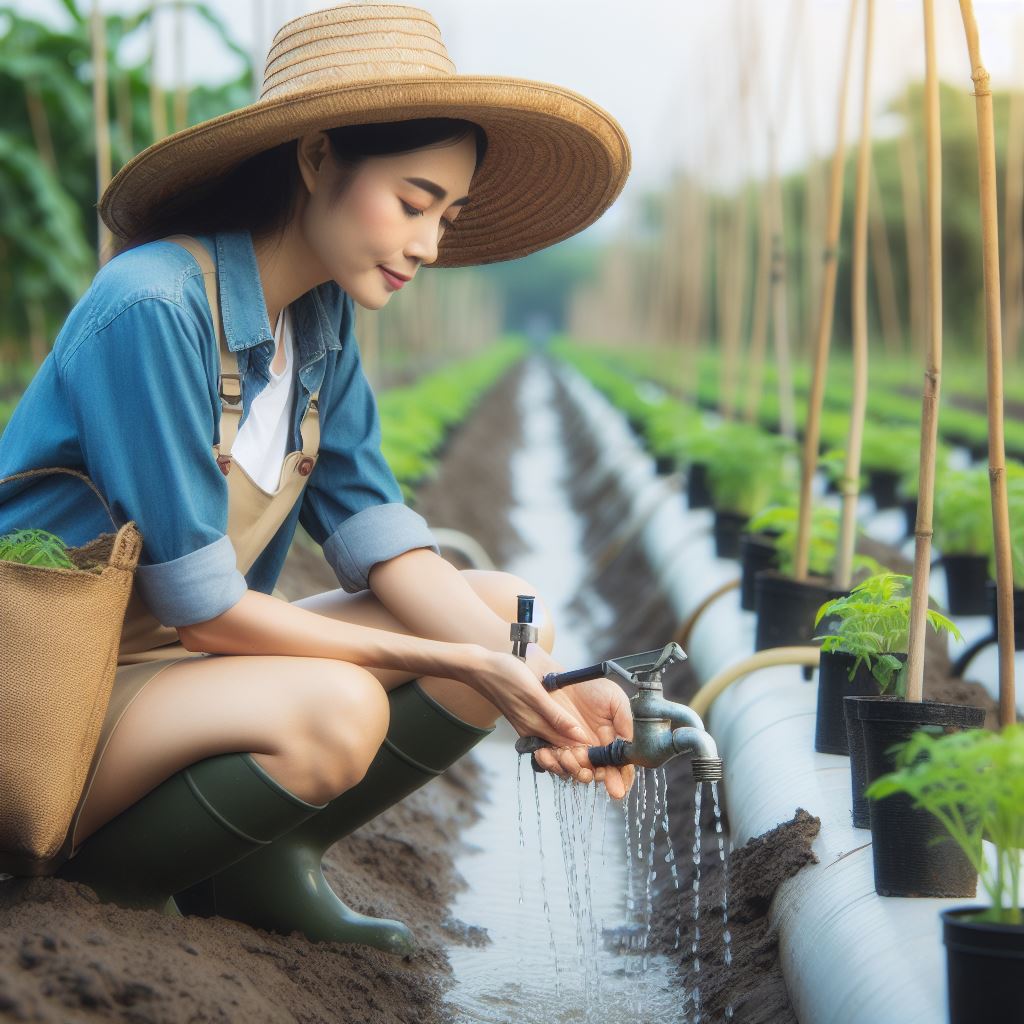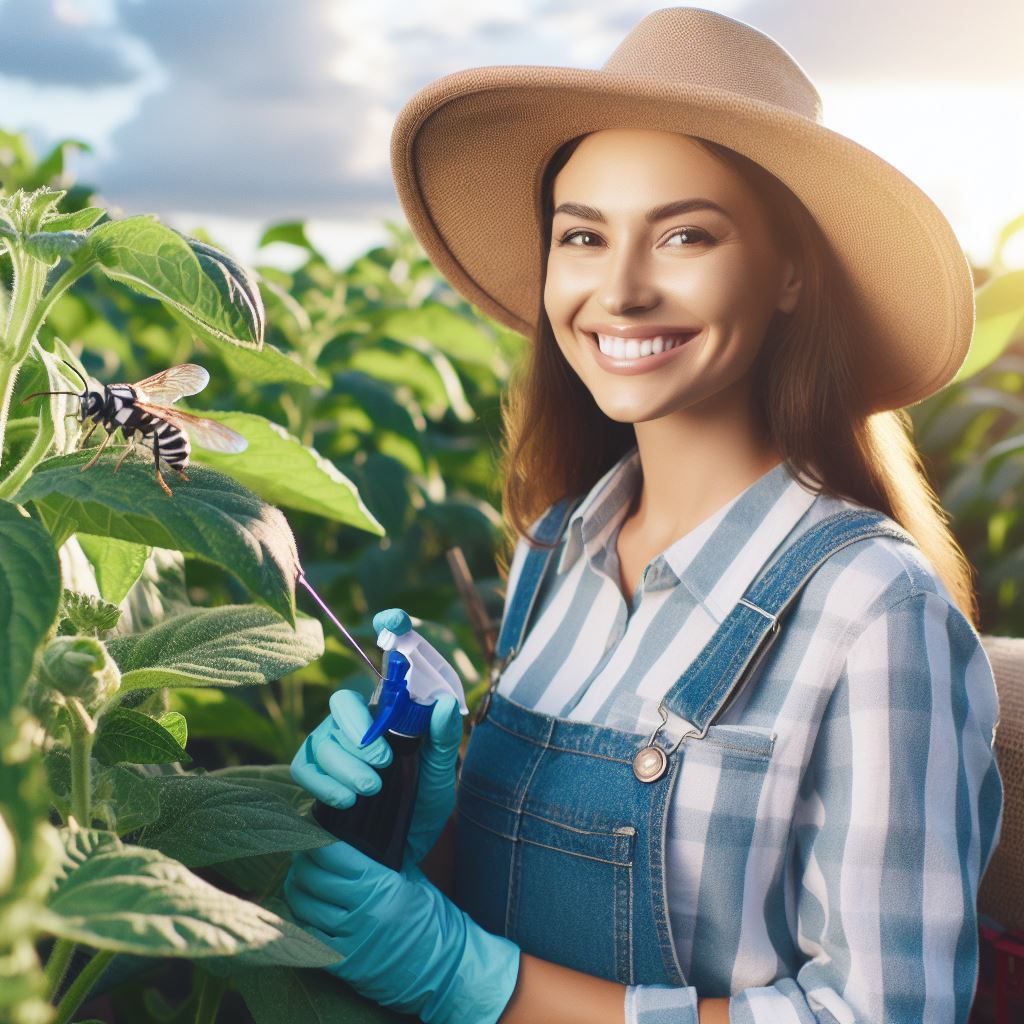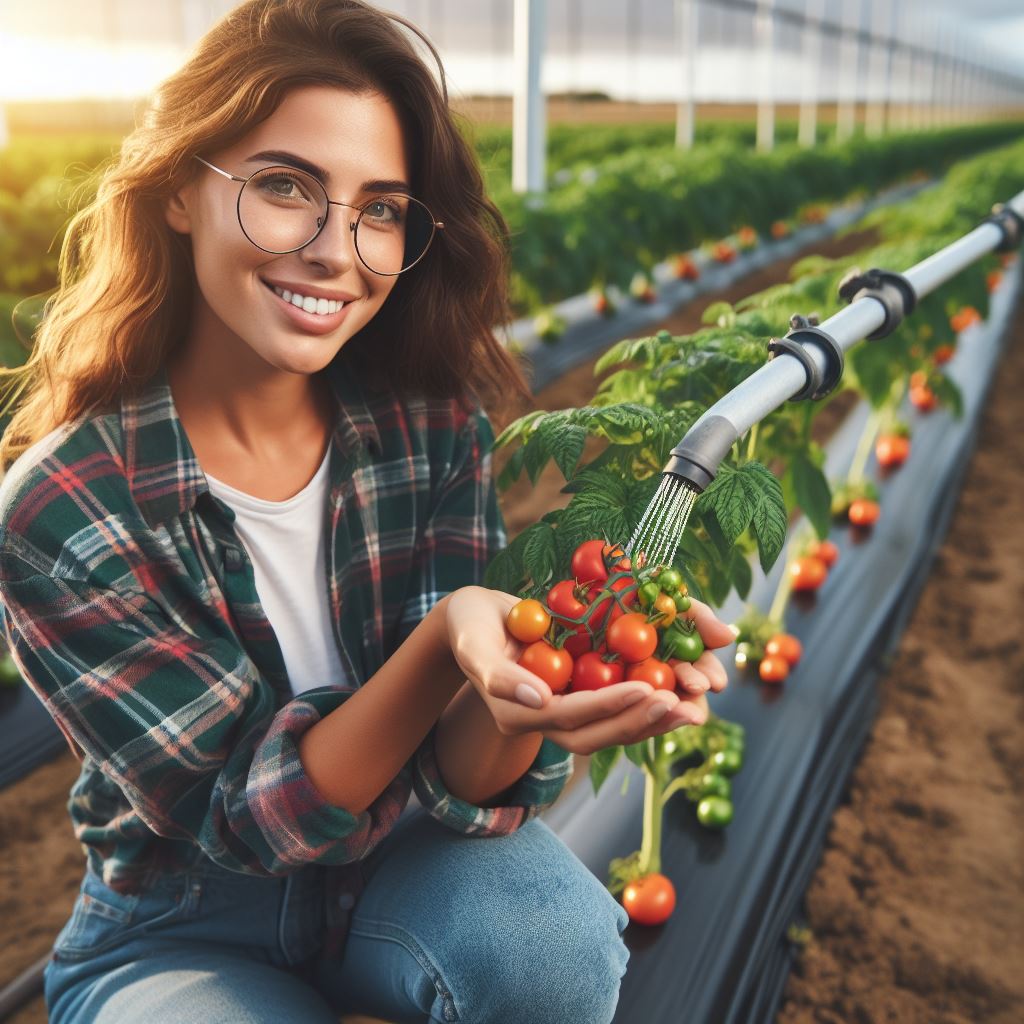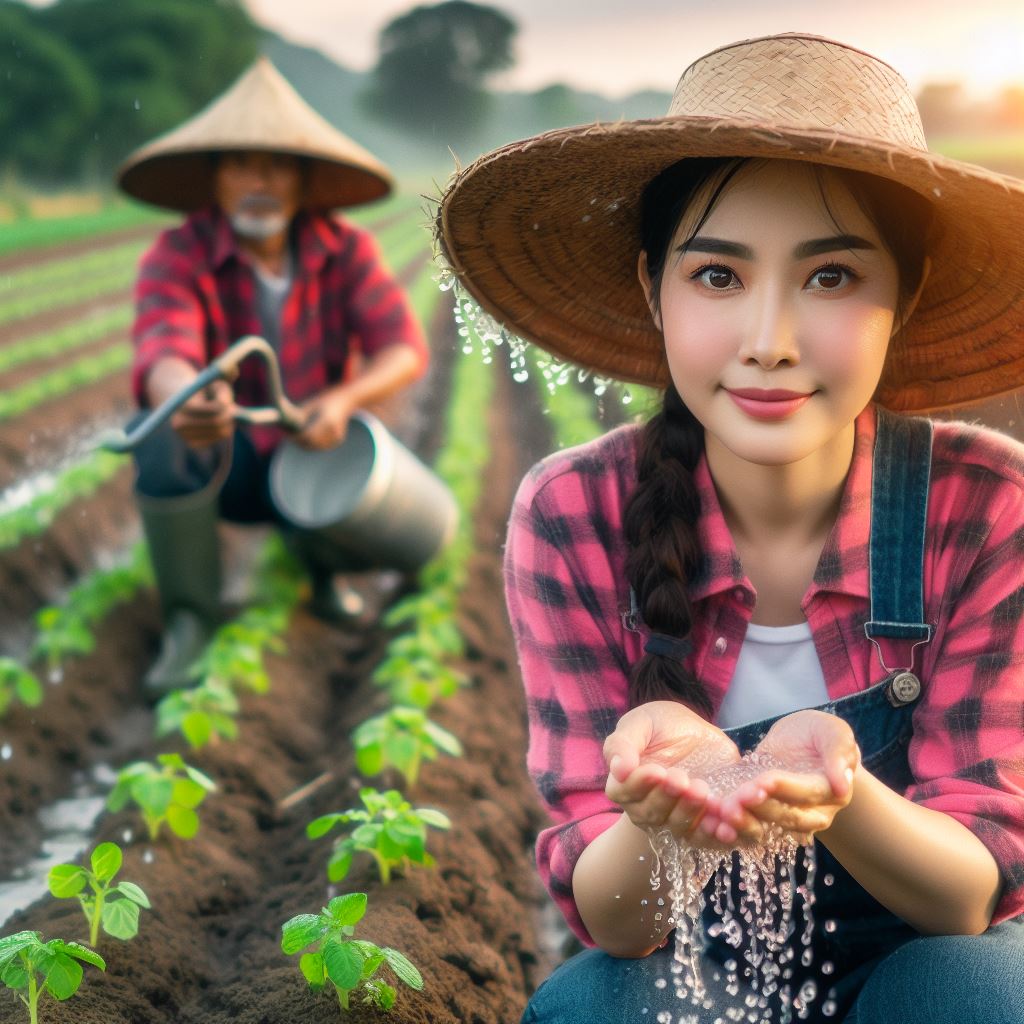Introduction
Water is a vital resource in modern agriculture, and its conservation is of utmost importance.
Water conservation in agriculture is crucial for sustainable food production and environmental balance. Agriculture consumes a substantial portion of global water resources, and efficient water management ensures that limited supplies are used wisely.
Conservation practices like drip irrigation, rainwater harvesting, and soil moisture monitoring help optimize water usage, reduce wastage, and mitigate the impact of water scarcity on crops.
Sustainable water practices in agriculture also support biodiversity, prevent soil degradation, and contribute to overall ecosystem health.
Given the growing global population and increasing water stress, prioritizing water conservation in agriculture is essential for long-term food security and environmental sustainability.
In this blog post, we will discuss the significance of water conservation in agriculture and the purpose of this post.
Understanding Water-Saving Techniques
Definition and significance
Water-saving techniques in modern agriculture refer to the various methods and practices implemented to minimize water usage while maximizing crop production.
These techniques play a crucial role in sustainable agricultural development and resource conservation.
Water scarcity has become a global concern, and agriculture is one of the main sectors that heavily relies on water.
Adopting water-saving techniques helps in improving water-use efficiency, reducing wastage, and preserving this precious resource for future generations.
Benefits of water-saving techniques in modern agriculture
- Conservation of water resources: Implementing these techniques ensures that water is used wisely and efficiently, reducing the pressure on water sources and preventing depletion.
- Increased crop yields: Water-saving techniques enable farmers to provide plants with the necessary amount of water at the right time, leading to improved crop productivity and quality.
- Cost-effectiveness: By minimizing water use, farmers can significantly reduce their overall irrigation expenses, including energy costs, labor, and maintenance.
- Environmental sustainability: Water-saving techniques help in mitigating the environmental impact of agriculture, such as reducing soil erosion, minimizing water pollution from nutrient runoff, and preserving aquatic ecosystems.
- Adaptation to climate change: With the increasing frequency of droughts and unpredictable weather patterns, implementing water-saving techniques allows farmers to adapt to changing climatic conditions and secure their agricultural production.
Examples of water-saving techniques
Drip irrigation
This technique involves delivering water directly to the plant’s root zone, either through tubes or emitters.
By minimizing water loss through evaporation and deep percolation, drip irrigation can achieve higher water-use efficiency compared to traditional sprinkler systems.
Rainwater harvesting
Rainwater harvesting involves capturing and storing rainwater for later agricultural use.
By collecting rainwater from rooftops or other surface areas, farmers can supplement their irrigation needs during dry periods, reducing reliance on groundwater or surface water sources.
Precision irrigation
This technique utilizes advanced technologies such as soil moisture sensors and weather data to precisely determine the optimal timing and amount of irrigation required. By avoiding overwatering, precision irrigation minimizes water wastage and optimizes plant growth.
Transform Your Agribusiness
Unlock your farm's potential with expert advice tailored to your needs. Get actionable steps that drive real results.
Get StartedMulching
Mulching involves covering the soil surface with materials like straw, plastic film, or wood chips to reduce evaporation, suppress weed growth, and improve water infiltration. It helps in conserving soil moisture and reducing the frequency of irrigation.
Planting drought-tolerant crops:
Selecting and cultivating crop varieties that are more adapted to dry conditions can contribute to water conservation in agriculture.
Drought-tolerant crops require less water for growth and development, ensuring efficient use of the available water resources.
Generally, understanding and implementing water-saving techniques are essential steps towards sustainable and responsible agricultural practices.
By conserving water, farmers can contribute to a more resilient and secure food production system while preserving our planet’s most precious resource.
Drip Irrigation
Explanation of drip irrigation system
Drip irrigation is a method of providing water to plants by slowly dripping it directly to the roots.
How drip irrigation optimizes water usage
Drip irrigation optimizes water usage by delivering water directly to the plant roots, reducing evaporation and runoff.
Advantages and drawbacks of drip irrigation
Advantages
- Conserves water by reducing evaporation and runoff.
- Delivers water directly to plant roots, reducing weed growth.
- Allows precise control over water distribution, ensuring plants receive optimal amounts.
Drawbacks
- Initial installation costs can be high.
- Requires regular maintenance and cleaning to prevent clogging.
- Not suitable for all crops, especially those with shallow root systems.
Success stories and case studies
1. Success story: Israel’s Negev Desert
- Implemented drip irrigation to transform barren land into a green and fertile agricultural region.
- Increased crop productivity and reduced water usage.
2. Case study : California’s Central Valley
- Drip irrigation systems used in vineyards increased crop yields and saved water.
- Improved water efficiency led to sustainable farming practices and reduced environmental impact.
3. Case study: Indian farmers
- Adoption of drip irrigation helped farmers cope with water scarcity in arid regions.
- Increased crop yields, improved water management, and reduced labor costs.
4. Case study: Australian agriculture
- Drip irrigation systems used in vegetable farming increased water efficiency and crop quality.
- Improved profitability and sustainability of farms.
5. Success story: China’s Hebei province
- Implementation of drip irrigation led to increased yields of wheat and maize.
- Reduced water consumption and improved farmers’ income.
In fact, drip irrigation is an effective water-saving technique in modern agriculture. It optimizes water usage by delivering water directly to plant roots, reducing evaporation and runoff.
Despite some drawbacks, such as installation costs and maintenance requirements, drip irrigation offers numerous advantages. Success stories and case studies from around the world demonstrate its effectiveness in increasing crop productivity and conserving water resources.
By adopting drip irrigation, farmers can contribute to sustainable agriculture and combat water scarcity.
Rainwater Harvesting
Introduction to rainwater harvesting
- Rainwater harvesting is the practice of collecting and storing rainwater for later use.
- It has been used for centuries and is gaining popularity in modern agriculture.
Benefits and applications of rainwater harvesting in agriculture
Conserves water resources by reducing dependency on freshwater sources.
- Improves water quality by reducing runoff and soil erosion.
- Provides a reliable water supply for irrigation during dry periods.
- Reduces reliance on expensive and energy-intensive water pumping systems.
- Helps in the restoration of groundwater levels, benefiting overall water availability.
- Supports sustainable farming practices by reducing environmental impacts.
Techniques and systems used for rainwater harvesting
- Roof catchment systems: Direct rainwater collection from rooftops into storage tanks or reservoirs.
- Surface runoff systems: Channels and ditches are used to channel rainwater into storage ponds or tanks.
- In-ground collection systems: Rainwater is collected in underground storage tanks or wells.
- Green infrastructure: Natural features like swales, ponds, and wetlands are used to capture and store rainwater.
Examples and success stories
- Kalpana Chawla Agricultural Center, Haryana, India: Implemented rainwater harvesting systems to overcome water scarcity and increase crop yield.
- Amboseli National Park, Kenya: Rainwater harvesting techniques supported local communities in sustaining agriculture during drought conditions.
- Tarumitra, Bihar, India: Rainwater harvesting structures transformed arid lands into fertile agricultural areas.
- Instituto Experimental Tropical, Costa Rica: Rainwater harvesting systems enabled sustainable agriculture practices in tropical environments.
- La Juanita, Argentina: Small-scale farmers implemented rainwater harvesting to overcome water scarcity and achieve food security.
Rainwater harvesting is a valuable technique in modern agriculture, offering numerous benefits and solutions.
By harvesting rainwater, farmers can reduce their dependence on freshwater sources, optimize water usage, and support sustainable farming practices.
Various techniques, such as roof catchment systems and surface runoff systems, can be implemented to collect and store rainwater.
Additionally, success stories from different parts of the world showcase the positive impact of rainwater harvesting in agriculture.
From enhancing crop yield in water-scarce regions to transforming arid lands into fertile areas, rainwater harvesting proves to be a promising solution for water conservation and agricultural sustainability.
Read: Soil Testing: Key to Effective Fertilization

Precision Irrigation
Overview of precision irrigation techniques
Precision irrigation techniques refer to advanced methods that ensure efficient water usage in agriculture.
These techniques involve delivering water directly to the plants in a controlled manner, minimizing wastage.
Benefits and importance in water conservation
- Water conservation: Precision irrigation techniques significantly reduce water wastage by delivering water only where it is needed.
- Increased crop yield: By providing water directly to the plants, precision irrigation ensures optimal growth, leading to higher crop yields.
- Improved nutrient delivery: Precision irrigation allows for precise control over water and nutrient delivery, ensuring plants receive the required nutrients efficiently.
- Energy savings: The use of precision irrigation technologies can lead to energy savings as water is delivered exactly when and where it is needed, reducing pumping requirements.
Technologies used in precision irrigation
- Soil moisture sensors: These sensors measure the moisture content in the soil, enabling farmers to irrigate only when necessary.
- Weather-based irrigation controllers: These controllers use real-time weather data to adjust the irrigation schedule based on evapotranspiration rates and forecasted precipitation.
- Drip irrigation systems: Drip irrigation delivers water directly to the base of plants, minimizing evaporation and runoff.
- Sprinkler systems with nozzle control: These systems use precision nozzles to distribute water evenly, avoiding overwatering and ensuring uniform coverage.
Real-world examples and their outcomes
- Netafim: Netafim, a pioneer in precision irrigation, implemented their technologies in a vineyard in California. The outcome was a 25% reduction in water usage and an increase in crop yield and quality.
- Jain Irrigation Systems: Jain Irrigation Systems implemented their precision irrigation techniques in a sugarcane farm in India. Water usage was reduced by 35% while maintaining high yields.
- Toro Precision Soil and Weather Sensor System: This system was used in a cotton field in Texas, resulting in a 43% reduction in irrigation water consumption and an increase in yield and fiber quality.
Generally, precision irrigation techniques play a crucial role in modern agriculture, offering numerous benefits such as water conservation, increased crop yield, improved nutrient delivery, and energy savings.
By utilizing technologies like soil moisture sensors and weather-based irrigation controllers, farmers can optimize water usage while achieving sustainable agricultural practices.
Real-world examples demonstrate the effectiveness of precision irrigation in achieving water-saving goals and enhancing overall productivity.
Read: Pest-Resistant Crops Explained
Uncover the Details: Effective IPM for Common Crop Pests
Showcase Your Farming Business
Publish your professional farming services profile on our blog for a one-time fee of $200 and reach a dedicated audience of farmers and agribusiness owners.
Publish Your ProfileOther Water-Saving Techniques
In addition to the water-saving techniques mentioned earlier, several other methods can be adopted in modern agriculture to further conserve water resources.
Let’s explore these techniques in more detail.
Cover cropping and reduced tillage
Cover cropping involves planting specific crops, such as legumes or grasses, during the off-season or between main crops.
These cover crops help protect the soil from erosion, improve soil structure, and retain moisture by reducing evaporation.
In addition to that, cover crops add organic matter to the soil, enhancing its water-holding capacity.
Reduced tillage practices minimize soil disturbance, leading to reduced water loss through evaporation. By disturbing the soil less, farmers can preserve soil moisture, resulting in higher water efficiency.
Furthermore, reduced tillage practices contribute to better soil health and nutrient retention, which are vital for sustainable agriculture.
Mulching and soil management
Mulching is another effective technique for conserving water in agriculture. It involves covering the soil surface with materials like straw, wood chips, or plastic sheets.
Mulch acts as a barrier, reducing soil temperature fluctuations and minimizing moisture loss through evaporation. Additionally, it controls weed growth, preventing water competition with crops.
Implementing proper soil management practices is crucial for improving water-saving capabilities. Techniques such as adding organic matter, compost, and biochar to the soil enhance its water-holding capacity and overall fertility.
By improving soil structure, farmers can improve infiltration and reduce surface runoff, thereby minimizing water wastage.
Crop rotation and companion planting
Crop rotation is a practice where different crops are grown in a specific sequence on the same field over time. This technique helps break pest and disease cycles, reducing the need for chemical inputs and irrigation.
By varying the root structures and nutrient requirements of different crops, farmers can optimize water use and avoid water stress in a particular area.
Companion planting involves growing compatible plant species together to maximize space, nutrient utilization, and pest control.
Certain plant combinations reduce water competition between crops, as their root systems occupy different soil depths. Additionally, companion planting can improve nutrient uptake, reducing the reliance on fertilizers and water.
Exploring aquaponics and hydroponics
Aquaponics and hydroponics are innovative techniques that maximize water efficiency in agriculture.
Aquaponics combines aquaculture (fish farming) and hydroponics (cultivating plants without soil). In this system, nutrient-rich fish water is cycled through plant beds, providing natural fertilization while conserving water.
This closed-loop system minimizes water loss through traditional irrigation methods.
Hydroponics, on the other hand, involves growing plants in nutrient-rich water without soil. This soil-less cultivation method reduces water consumption significantly compared to conventional farming.
By directly delivering nutrients to the roots, hydroponics optimizes resource utilization and allows for higher crop yields in smaller areas.
Essentially, by implementing cover cropping, reduced tillage, mulching, soil management, crop rotation, companion planting, aquaponics, and hydroponics, modern agriculture can effectively conserve water resources.
These techniques not only minimize water wastage but also contribute to soil health, fertility, and overall sustainability of farming practices.
Embracing such water-saving strategies is crucial for the future of agriculture, ensuring food security and protecting our precious water supplies.
Read: Boosting Yield with Crop Choice
Challenges and Considerations
Cost and implementation challenges
- Water-saving techniques in modern agriculture can be expensive to implement.
- The initial investment required for installing advanced irrigation systems might pose financial challenges.
- Farmers might face difficulties in accessing financial resources to adopt water-saving techniques.
- Retrofitting existing agricultural infrastructure to incorporate water-saving technologies can be costly.
- The high electricity costs associated with running water-efficient systems add to the implementation challenges.
Balancing water-saving techniques with crop productivity
- Farmers need to strike a balance between water conservation and maintaining optimal crop yields.
- Overly restrictive water-saving measures can negatively impact crop growth and productivity.
- Precision irrigation techniques must be carefully calibrated to provide crops with the right amount of water.
- Research is needed to determine the optimal water requirements for different crops.
- Balancing crop water needs with the efficient use of water resources is crucial for sustainable agriculture.
Regulatory and policy considerations
- Effective water management policies and regulations must be in place to promote water-saving practices.
- Governments should incentivize farmers to adopt water-saving technologies through subsidies or tax benefits.
- Collaborative efforts between policymakers, researchers, and farmers are necessary for effective implementation.
- Clear guidelines on water usage and restrictions can ensure compliance and promote responsible water use.
- Regular monitoring and evaluation of water-saving practices can help refine policies and address emerging challenges.
Collaboration and knowledge-sharing initiatives
- Information sharing among farmers, researchers, and extension services is essential for successful adoption.
- Collaborative platforms, such as farmer networks and agricultural associations, can facilitate knowledge exchange.
- Sharing best practices and success stories can encourage more farmers to embrace water-saving techniques.
- Research institutions and universities play a vital role in disseminating knowledge and promoting innovation.
- Public-private partnerships can promote joint research and investment in water-saving technologies.
In general, the adoption of water-saving techniques in modern agriculture is not without its challenges and considerations.
The cost and implementation hurdles, balancing crop productivity, regulatory policies, and collaboration efforts all need careful attention.
However, by addressing these challenges, we can pave the way for sustainable water use in agriculture, ensuring the long-term viability of our food production systems.
Read: Top Planting Methods Compared
You Might Also Like: Crop Disease Control: Organic Solutions
Find Out More: Planting for Continuous Harvest
Conclusion
Recap of the importance of water-saving techniques in modern agriculture
Water-saving techniques are vital in modern agriculture as they help conserve water resources and ensure sustainable farming practices.
Encouragement for farmers to adopt water-saving practices
Farmers should embrace water-saving practices to minimize water wastage, reduce costs, and maximize crop yield, leading to improved profitability and environmental stewardship.
Final thoughts and call to action
The adoption of water-saving techniques in modern agriculture is essential for the survival of our planet.
Farmers play a crucial role in implementing these practices to secure a sustainable future.
Let us all join hands and prioritize water conservation to protect our natural resources and ensure food security for generations to come. Act now!




